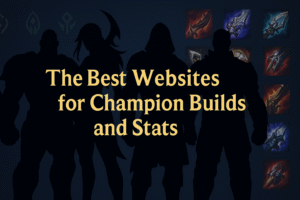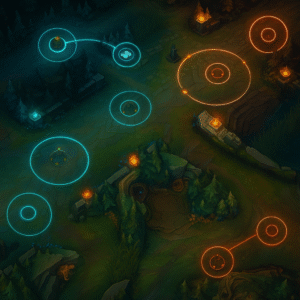For new players, League of Legends can feel overwhelming. With over 160 champions, hundreds of items, and fast-paced team fights, it’s easy to get lost. But no matter your champion or role, there’s one thing every player shares: the map.
Summoner’s Rift is more than just the battlefield—it’s the foundation of the game. Understanding the map helps you:
- Position better in lane and fights.
- Secure objectives like Dragon and Baron.
- Use vision to avoid ganks.
- Rotate effectively with your team.
This beginner’s guide to understanding the map will break down every part of Summoner’s Rift so you can navigate like a pro.
Chapter 1: The Layout of Summoner’s Rift
Summoner’s Rift is a symmetrical, three-lane map designed for 5v5 gameplay. Here’s the breakdown:
1.1 The Three Lanes
- Top Lane: Long, isolated lane for bruisers and tanks.
- Mid Lane: Short lane for mages and assassins.
- Bot Lane: Paired lane for ADCs and supports.
1.2 The Jungle
- Areas filled with neutral monsters.
- Provides XP, gold, and strategic control.
- Home to Dragons, Rift Herald, and Baron.
1.3 The Bases
- Each team has a Nexus (the ultimate win condition).
- Bases contain turrets, inhibitors, and the fountain.
1.4 The River
- Divides the map diagonally.
- Contains Scuttle Crabs and key objectives.
- Strategic chokepoint for vision and fights.
For beginners, learning lane placement and jungle paths is the first step to reading the map.
Chapter 2: The Objectives
2.1 Towers (Turrets)
- Defend each lane.
- Provide gold when destroyed.
- Beginners’ tip: never dive under turrets early—they deal massive damage.
2.2 Inhibitors
- Behind inner towers in base.
- Destroying them spawns super minions.
- Important for late-game pressure.
2.3 Nexus
- The final target—destroy it to win the game.
2.4 Dragons
- Elemental buffs: Infernal (damage), Mountain (defense), Ocean (regen), Cloud (speed).
- Dragon Soul grants permanent power.
2.5 Rift Herald
- Early-game objective (spawns top side).
- Helps push towers with its charge.
2.6 Baron Nashor
- Late-game objective.
- Grants Baron Buff (empowered minions, combat power).
2.7 Jungle Camps
- Blue Buff (mana regen + CDR).
- Red Buff (slow + burn damage).
- Raptors, Wolves, Gromp, Krugs for XP and gold.
For beginners, focus on understanding why objectives matter: Dragons and Baron often decide games more than kills.
Chapter 3: Lanes and Roles
3.1 Top Lane
- Champions: Tanks, bruisers (Garen, Darius, Malphite).
- Responsibilities: Sustain, split-push, frontline in fights.
3.2 Jungle
- Champions: Initiators, tanks, assassins (Lee Sin, Warwick, Amumu).
- Responsibilities: Control jungle camps, gank lanes, secure objectives.
3.3 Mid Lane
- Champions: Mages, assassins (Lux, Zed, Ahri).
- Responsibilities: Wave control, roaming, damage output.
3.4 Bot Lane (ADC + Support)
- ADC: Ranged damage dealer (Jinx, Kai’Sa).
- Support: Protects ADC, controls vision (Leona, Soraka).
Chapter 4: Vision and Warding
Vision wins games. Beginners often forget wards, but they’re essential.
4.1 Types of Wards
- Stealth Ward: Basic green ward, lasts a few minutes.
- Control Ward: Pink, reveals enemy wards.
- Farsight Alteration: Blue trinket for scouting safely.
4.2 Key Ward Spots for Beginners
- River bushes near Dragon and Baron.
- Tri-bushes near lanes.
- Enemy jungle entrances during mid/late game.
4.3 Map Awareness Tips
- Look at minimap every 5–10 seconds.
- Track missing enemies with pings.
- Watch for objectives spawning soon.
Chapter 5: Rotations and Map Movement
Map movement is what separates beginners from advanced players.
- Roaming: Leaving lane to help others. Mid laners often roam bot for 2v4 fights.
- Jungle Pathing: Learning how junglers move helps predict ganks.
- Objective Control: Rotate as a team when Dragon/Baron is spawning.
- Split Pushing: Pressure side lanes while your team takes objectives elsewhere.
Chapter 6: Early, Mid, and Late Game Map Play
6.1 Early Game (0–14 min)
- Focus on last-hitting minions.
- Ward river to avoid ganks.
- Jungler: prioritize first Dragon or Rift Herald.
6.2 Mid Game (15–25 min)
- Rotate for towers and Dragons.
- Group with team when objectives are contested.
- Ward deeper into enemy jungle.
6.3 Late Game (25+ min)
- Stick with your team—one mistake can cost the game.
- Baron and Elder Dragon become win conditions.
- Map awareness becomes crucial—control vision around objectives.
Chapter 7: Common Beginner Mistakes
- Ignoring wards → getting ganked often.
- Chasing kills instead of taking towers.
- Overextending without vision.
- Forgetting to recall before big fights.
- Not grouping late game when it matters most.
Chapter 8: Pro Tips to Understand the Map Faster
- Play ARAM occasionally → helps learn champion kits without worrying about jungle.
- Watch minimap more than your champion → pro players spend 60% of their time scanning the map.
- Follow streamers → watch how they ward and rotate.
- Use practice tool → walk the map to memorize jungle camp timers and ward spots.
Chapter 9: How Pros Use the Map
Professional teams use Summoner’s Rift like a chessboard:
- Early wards track junglers perfectly.
- Lane priority decides who secures objectives.
- Rotations turn small leads into global pressure.
Watching LCK or Worlds matches is one of the fastest ways to understand high-level map play.
Conclusion: Mastering the Rift Step by Step
For beginners, the map might seem intimidating, but mastery comes with time. By learning the lanes, jungle, objectives, and vision, you’ll develop strong fundamentals that make every ranked game easier.
The LoL Beginner’s Guide to Understanding the Map is your foundation: control vision, rotate smartly, and play around objectives—not just kills. Once you master the Rift itself, climbing ranked becomes much smoother.







